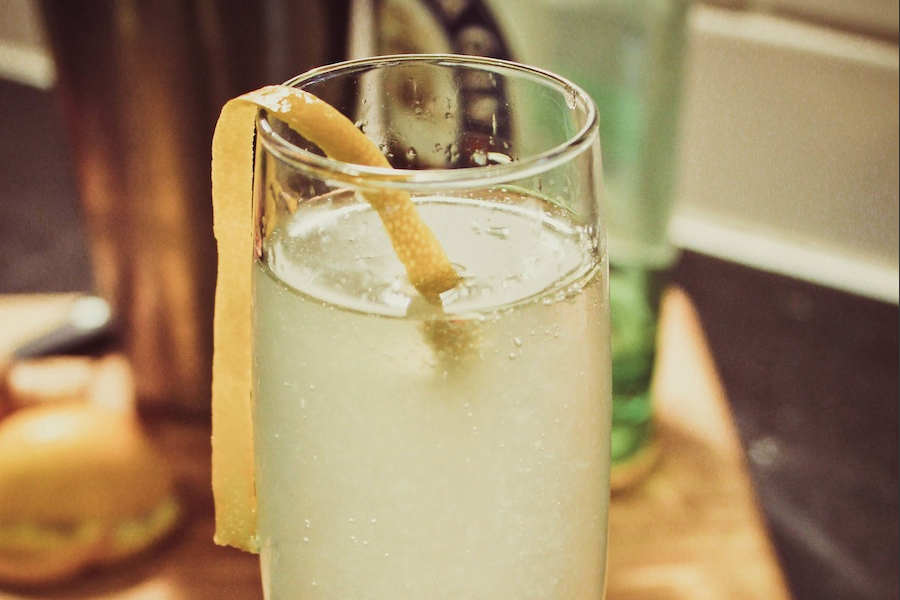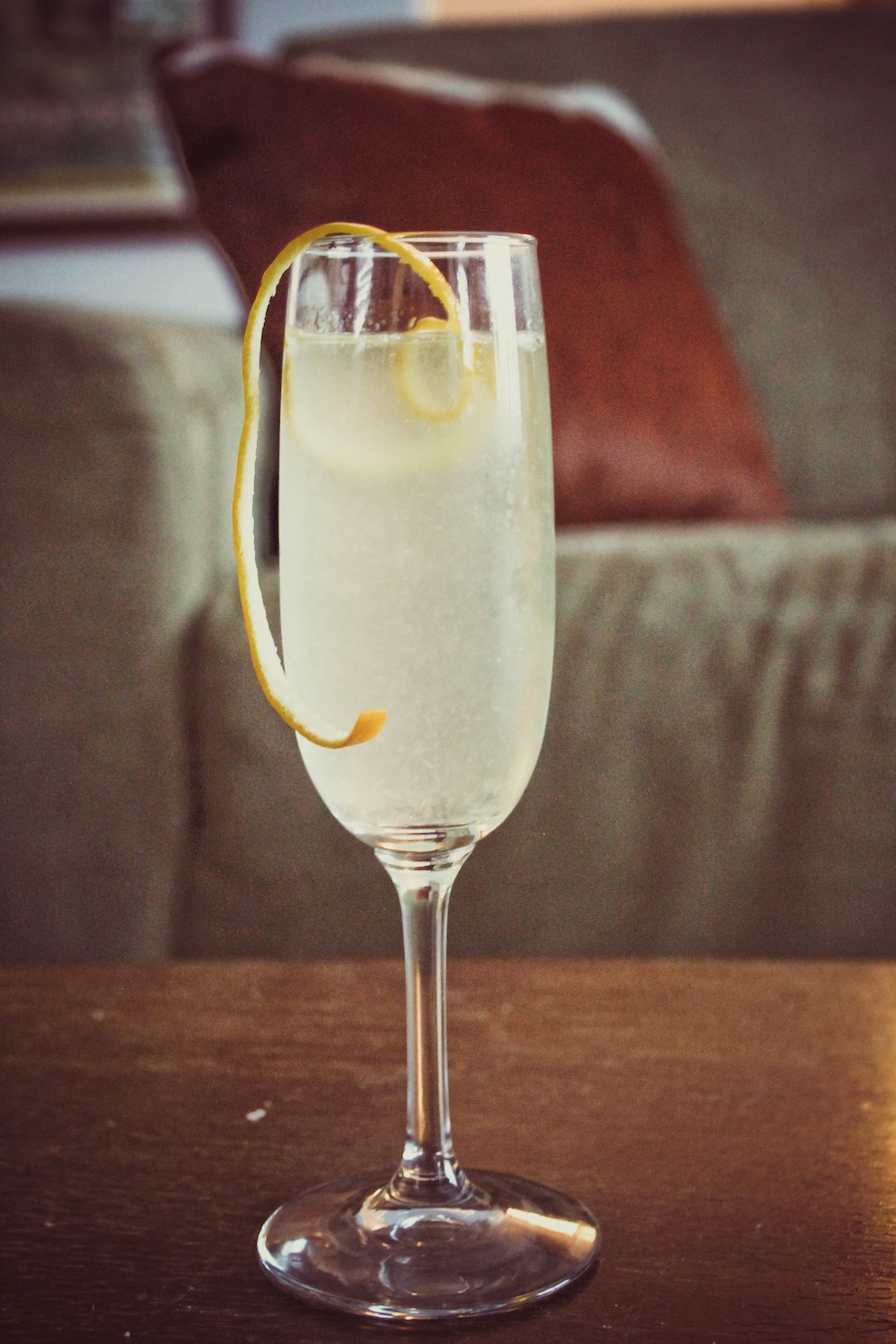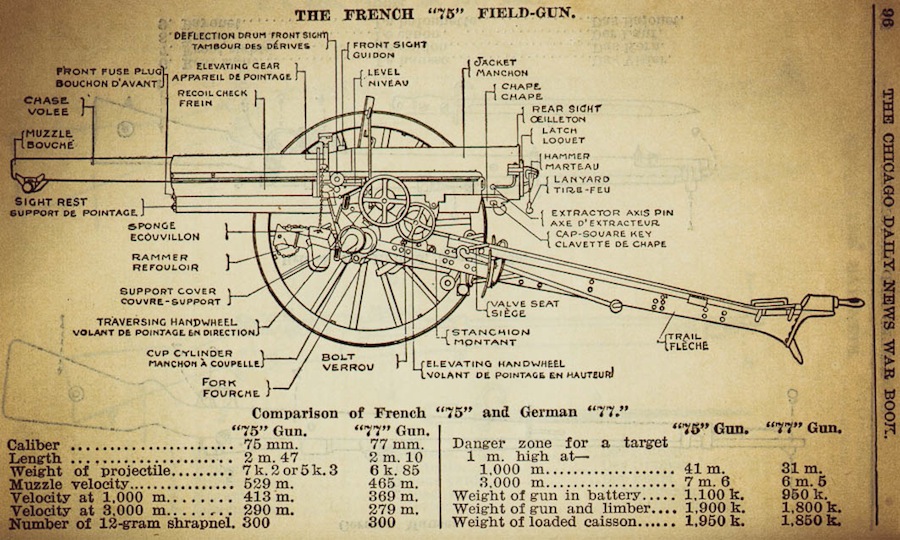There’s something about a champagne cocktail that cranks the flyin’ high freak-flag level of any event right up to 11 from the first toast, and the French 75 is arguably THE classic bubbly cocktail. Fair warning: it’s the kind of cocktail that sneaks up on you like a velvet sledgehammer. After a few of these, you’ll be stumbling into the next day wearing nothing but a tuxedo jacket and false eyelashes. That don't belong to you.
It’s deceptively simple in both ingredients and method: just a bit of sugar, lemon juice, a shit-load of gin, and all that topped with champers. Think of the French 75 as a gateway cocktail for grouchy asshats who say they “hate gin” after a G&T experience gone bad in their early drinking years [I’m talkin’ to you, Les]. They’ll be gulping this puppy down and asking for another round after two slugs, gauranteed.*
Long before the “The French 75” showed up as a cocktail recipe in post-WWI bar books, champagne-liquor combos [made with gin or cognac] were famously guzzled by fellas of Victorian-era nobility and the dapper folks who emulated them on both sides of the Atlantic. Although cocktail geeks argue over where, and by whom, the French 75 cocktail was developed and named, all agree that the moniker stuck after WWI to celebrate the French 75 millimeter field gun [neat-o photo below]. ‘Twas a piece of artillery prized by French and American troops during WWI who appreciated its kickass power, speed, and accuracy all packed in an efficient and mobile design. Apropos for this potent drink. It’s one of the few early, 20th century American cocktail classics that gained popularity during Prohibition; even bathtub gin tastes pretty goddamn good if it’s mixed with enough sugar, lemon, and bootlegged bubbly.
Like many classics, everyone’s got their favorite way to spin the sauce. Here’s our take:
THE BOOZE: Most barkeeps use gin for this drink, although if you order a French 75 in New Orleans, it’ll probably be made with cognac. Tasty. Within gin’s basic formula there’s a huge range of floral-herbal notes goin’ on underneath all that requisite juniper; any decent London Dry gin nicely complements the citrus/sweet of a French 75. It doesn’t need to be the priciest bottle on your shelf; save that for making martinis or for impressing that annoying douche who says, “I’ll only drink _________.” #compensator
THE CITRUS: To get the most juice out of a lemon, microwave one on ‘high’ for about 10 seconds, then roll it with the flattened palm of your hand firmly against a hard surface [table, cutting board, etc.]. Before you start squeezing out the juice, take a minute to cut out a wafer thin wedge of lemon or knife some peel off in a long string of zest for garnish. No, you philistine, you can’t use lemon juice from a plastic bottle for cocktails. Ever.
THE SUGAR: Superfine sugar [sometimes called “Baker’s sugar”] dissolves more readily in lemon juice than large-grained sugars like turbinado, but any pale-colored sugar will do. Some recipes call for using simple syrup, instead [see my quick and dirty method here].
THE BUBBLY: You know champagne can’t be called “Champagne” unless it comes from the Champagne region of France, right? That said, French 75s were almost exclusively made back in the day with French Champagne. Very good, bubbly wines made using the same method and similar grapes come from all over the world: Spain’s Cava, Italy’s spumante and Prosecco [among others], German Sekt. In the U.S. and other English-speaking countries, it’s usually and underwhelmingly called “sparkling wine” [yawn]. Adding to the confusion, sparkling wines have a wide range of sweetness [Brut sauvage, demi-sec, extra Dry, etc]. Since this cocktail is made with sugar and citrus, lower sugar “Brut” wines make a great French 75, but you can totally play with the sugar:bubbly ratio for what you’ve got on hand.
THE ROCKS: Drink nerds are gonna get all up in here about this one. There are two major camps of French 75 recipes: both equally delish IMHO [step down, people. Jeezus y’all try my patience]. Some bartenders vigorously shake everything except for the bubbly in a cocktail shaker filled with ice, strain the drink into a chilled champagne flute or coupe glass, and then add champagne to the rim. Other mixologists strain the shaken gin-citrus-sugar mixture into a tall narrow Collins glass almost completely filled with chipped ice, then add champagne to the top of the glass. Let’s call it even: In the winter I like my French 75 strained into a champagne glass, and in the summer prefer it over ice and served with a straw [so I don’t smear my lipstick, psht]. ‘Sup to you. Let’s shake some up, shall we?
Meyer Lemon French 75 [Serves one. Meyer lemons — slightly rounder, sweeter, juicier, and thinner-skinned than regular lemons — are in season right now and make a delicious cocktail, but regular fresh lemon juice works just fine].
To a cocktail shaker filled with ice, add 1 ½ oz. gin, ½ oz. Meyer lemon juice, and ½ oz. simple syrup. Shake that mutha vigorously, until the shaker is frosty...then strain into a coupe or champagne glass. Top with 2 - 3oz of sparkling wine, and float a small lemon wedge or long strip of lemon zest on the surface of the cocktail. Drink up, fancy.
French 75 [Serves one. This would be “The Classic” version, by booze historian David Wondrich for Liquor.com]
Add ½ oz lemon juice and 1 tsp. sugar to a shaker, and stir to combine. Then add 2 oz. London Dry gin or Cognac and fill with ice. Shake, and strain into a Collins [or other tall, narrow] glass filled with cracked ice. Fill slowly with chilled champagne and get to sippin'.
Arnaud’s Louisiana French 75 [Serves one. The classic New Orleans version served at the historic bar at Arnaud’s restaurant. From April, 2013 Saveur magazine].
Combine 1 ¼ oz. cognac [they use Courvoisier VS], ¼ oz. fresh lemon juice, and ¼ oz. simple syrup in a cocktail shaker filled with ice. Shake and pour into a champagne flute. Top with chilled champagne [Arnaud’s pick: Moët & Chandon Imperial] and garnish with a small piece of lemon peel. #ohmygoditsgood
*Don’t worry gin lovers, we’ll tackle the gimlet and martini in a Cocktails 101 blog soon. Hold ‘yer horses, ya filthy animals.










